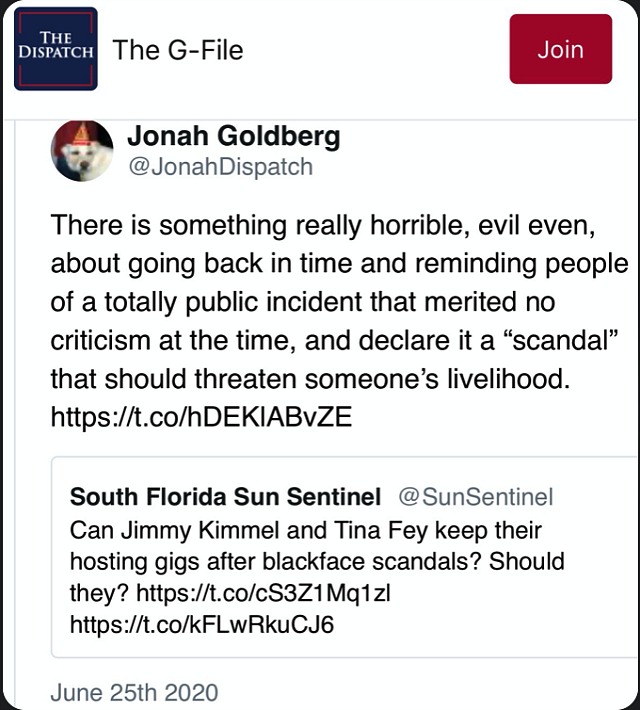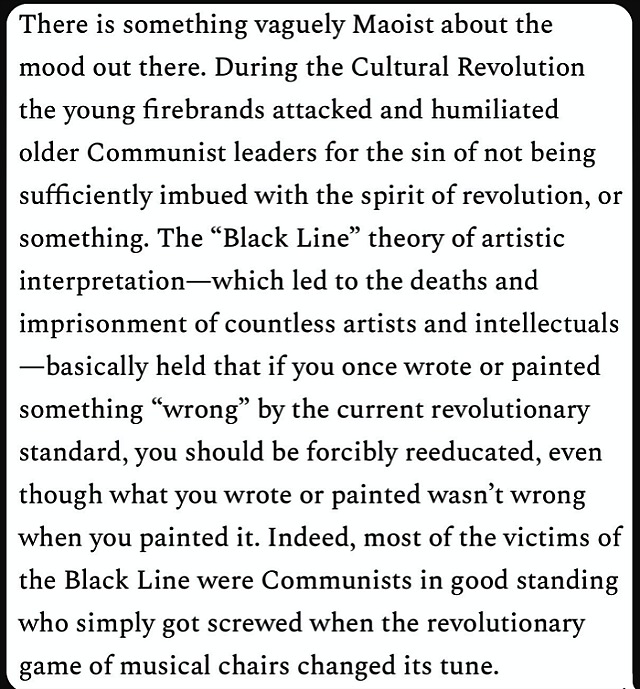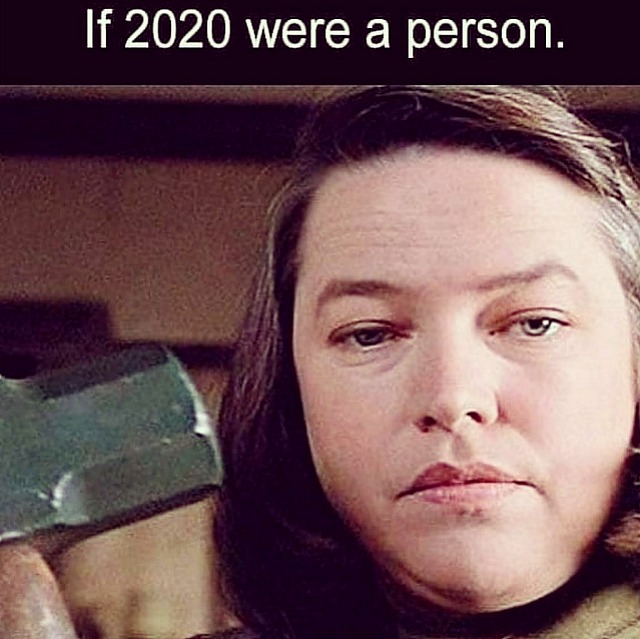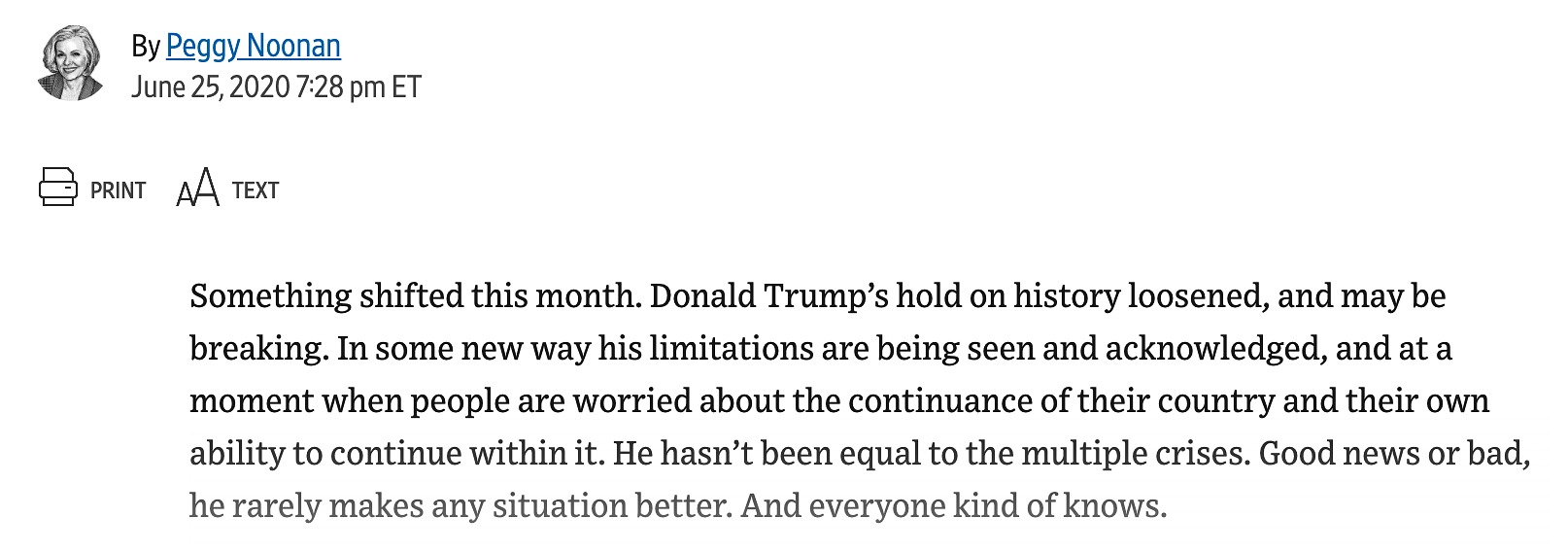From “The Maoist Nature of the New War on Wrongthink,” posted by The Dispatch‘s Jonah Goldberg on 6.26.20:



From “The Maoist Nature of the New War on Wrongthink,” posted by The Dispatch‘s Jonah Goldberg on 6.26.20:



Posted on 2.16.05: There are at least three ways to have a depressing time at the movies, and one is worth the grief.
One, you can sit through something shoddy, inept and sub-standard, and do everything you can to flush it out of your system when it’s over. Two, you can sit through a smooth, studio-funded, well-made enterprise that everyone’s loving and is making money hand over fist, but which you happen to despise with every fibre of your being. Or three, you can watch a heartfelt, quality-level downer and come out saying “huh, that was sad but edifying.”
Movies that relay or reflect basic truths will never be depressing, but those that tell lies of omission by way of fanciful bullshit always poison the air.
Sadness in good movies is not depressing — it’s just a way of re-experiencing honest hurt. Ordinary People is sad, but if you think it’s depressing as in “lemme outta here” there’s probably something wrong with you.
I’ll give you depressing: living a rich full life (children, compassion, wealth, adventure) and then dying at a ripe old age, and then coming back (i.e., reincarnated) as a chicken at a Colonel Sanders chicken ranch.
My beef is with movies that impart a distinct feeling of insanity by way of delirium or delusion, or a bizarre obsession. Frank Darabont‘s The Green Mile (turn on the current! smell that burning flesh! cuddle that cute mouse!) and The Majestic (rancid small-town “folksiness”) are two such films. Ditto Steven Spielberg‘s Always .
Martin Scorsese‘s Kundun isn’t exactly a downer. It’s worse than that — it’s paralyzing. And yet Scorsese made one of the greatest spiritual-high movies ever with The Last Temptation of Christ.
On the other hand, Marty sent thousands upon thousands of moviegoers into states of numbing depression when Sharon Stone gave Joe Pesci a blowjob in Casino.
Leaving Las Vegas, Mike Figgis‘ film about a lush who’s decides to drink himself to death and doesn’t quit until he succeeds, has never been and never will be depressing. (If you’re engaged to someone who thinks it is, tell him or her it’s over — you’ll be divorcing them eventually so you might as well get it over with.)
And yet the watching of John Huston‘s Under the Volcano, about a somewhat older guy (Albert Finney) doing more or less the same thing, is akin to accidentally overdosing on generic cold medication and having to tough it out until the effects wear off.
In her review of Peter Brooks‘ King Lear (’71), a profoundly dreary black-and-white thing with Paul Scofield in the title role, Pauline Kael wrote, “I didn’t dislike this film — I hated it.” I was so intrigued by this review that I eventually saw Brooks’ film, and I knew Kael wasn’t talking about what Brooks had done as much as the way his film made her feel deep down.
The Godfather, Part II is a fairly gloomy film but it doesn’t lie. It basically says that the ties that used to bind families and community together in the old days (the `40s and `50s) have been unraveling for some time. As Al Pacino‘s Michael Corleone says to his mother in the second act, “Things are changing.”
The Matrix Revolutions is a profoundly depressing film, especially when all those hundreds of thousands of sentinels start swarming into Zion like wasps. Absolutely relentless and thundering empty-coke-bottle bullshit.
Sitting through Ron Howard‘s Backdraft is like injecting an experimental psychotic drug concocted by Dr. Noah Praetorious (the frizzy-haired scientist in The Bride of Frankenstein) straight into your veins.
Charlie Savage, Eric Schmitt and Michael Schwirtz‘s N.Y. Times story about Russia secretly offering payment to Afghan militants for killing U.S. troops appeared late Friday (6.26). The Lincoln Project had this ad up and running sometime yesterday afternoon, or certainly by early evening.
Killer Times subhead: “The Trump administration has been deliberating for months about what to do about a stunning intelligence assessment.”
Killer YouTube comment: “Agent Orange wants a hotel and casino in Moscow. American lives mean NOTHING to him as evidenced by his pandemic response and his war against the Affordable Care Act. Now we see our soldiers are disposable cannon fodder. Putin is playing him like the incompetent dunce that he is. The world’s dictators are having a field day.” — Ellen Bryant, early this morning.
Steven Spielberg‘s Jaws opened almost exactly 45 years ago — 6.20.75. The trouble-plagued Universal release opened in 474 theatres that day, and then expanded to 675 theatres on 7.25.75 — the biggest mass release of a film ever seen at the time. It earned a staggering $7 million the first weekend, and stayed at the top for the next five weeks, ultimately becoming the first pic to top $100 million domestic.
I’ve acknowledged that for what it is, Jaws holds up fairly well. But it’s difficult to think of it these days as just a film. For years it’s been regarded (and not just by people like myself) as almost a sentinel of tragedy, as extreme as that may sound. It ushered in the era of the mass-market, four-quadrant tentpole movie, and in so doing almost single-handedly (i.e., along with the success of Star Wars two years later) turned the film industry away from the idea of smallish or mid-sized movies with flavor and personality being a legitimate thing to invest in.
Jaws and Star Wars, in short, brought high-concept greed into the mix, and from this the interest of corporations in the potential for even greater profits if movies could be sufficiently simplified and tailored to a younger (or more simple-minded) audience. This in turn set in motion forces that wound up dumbing down movies and injecting a kind of virus into the Hollywood system that basically poisoned the whole game, leading to the ascension of tentpole auteurs and dumber plots and faster and faster cutting and hundreds of orange fireballs in action sequences.
This cause-and-effect has been recounted and lamented by many thoughtful chroniclers, and doesn’t need to repeated once again. But Jaws did do it — it let slip the dogs of tentpole hell, and movies have never been the same since.
From the director of The Help, Get On Up and Girl On The Train. Sorry but I’m sensing a downward trajectory here. Good cast though — Jessica Chastain, John Malkovich, Common, Geena Davis, Colin Farrell, Ioan Gruffudd, Joan Chen. Nope, no way, not a chance.
Readers of the Michigan-based Creem magazine were devotees of raunch rock and enemies of prissy, fussified baroque rock — metal, early punk, Lou Reed, MC5, the Ramomes, the Boxtops, the Stooges, “96 Tears”, Joan Jett, Grand Funk Railroad, etc.
But (and I realize this will sound like an appalling opinion to some) rock music of the ’60s and ’70s encompassed richer, greater realms than were dreamt of by Creem philosophers. I dearly loved Phillip Seymour Hoffman‘s Almost Famous portrayal of legendary Creem critic Lester Bangs, but Bangs was more of a bully instructor than a critic who channelled, felt and explored. I respected Creem and its writers, but I never bought a single issue. Not out of antagonism or disdain — I just didn’t care enough.
Scott Crawford‘s Creem: America’s Only Rock ‘n’ Roll Magazine (Greenwich, 8.7) played at SXSW ’19 under a different title — Boy Howdy! The Story of CREEM Magazine.
From 3.10.29 Glide review by James Roberts: “In a way, the story of Creem is the story of late 20th century America. The magazine was as much a response to the culture as it was an impetus of culture. While the interviews tell the tale of wild debauchery and astounding feats of journalistic courage, they also hold up a mirror on the state of the culture at the time.
“It’s impossible to think of a single publication doing as much as Creem did for a particular scene in today’s culture. Today, even thumbing your nose feels like a marketing decision. Today, we build brands and conventions. It’s hard to imagine a publication where rock stars like Alice Cooper or Iggy Pop would go just to hang out. It’s hard to imagine a publication that would, in 40 years, inspire the likes of Kirk Hammett, Chad Smith, Keith Morris, Joan Jett and Michael Stipe to talk about it in a movie.”
Anyone who can shout this loudly almost certainly doesn’t have a “breathing problem.” No, there isn’t any way to reach “these people.”
This is a Trader Joe’s today. In Los Angeles. Cases are through the roof in California. Is there any way to reach these people?
— Joshua Potash (@JoshuaPotash) June 27, 2020
Joe Rogan and Jon Stewart talking easily to each other, and with each other. A lot of fundamental social justice stuff. But Rogan…how to say this?…doesn’t quite sound like his real self. He seems to be leaning in Stewart’s direction out of good manners, an instinct to accommodate, etc. Around the 21 minute mark he even sounds like a Bernie Sanders tax-and-spend social democrat. Is that who he is?
Alden Ehrenreich was riding high after his amusing performance as Hobie Doyle in Joel and Ethan Coen‘s Hail Caesar (’16). But his next three films delivered a triple-whammy effect, and the godz turned on him.
Ehrenreich’s amiable performance as Howard Hughes‘ chauffeur in Warren Beatty‘s Rules Don’t Apply (late ’16) did him no favors after the film bombed. He was wounded again when The Yellow Birds, in which Ehrenreich played the lead role, opened at Sundance ’17 and flatlined. Then came the final hammer blow with his underwhelming performance as young Han Solo in Solo: A Star Wars Story (’18), which opened roughly two years ago.
Ehrenreich dropped out of sight to lick his wounds and reassess the landscape. I was no fan of Solo or Yellow Birds, but I felt sorry for the guy.
Now AE is back as the lead in Brave New World (7.15, Peacock), a dystopian sci-fi drama (vague shades of THX-1138) based on the 1932 Aldous Huxley novel. Exec produced by David Wiener, co-written by Wiener, Grant Morrison and Brian Taylor. Gut reactions?
Aldous Huxley picked the wrong day to die from cancer — 11.22.63. He was tripping his brains out on LSD when he passed into eternity.
From “The Week It Went South For Trump,” a 6.25 Peggy Noonan essay in the Wall Street Journal:

James Carville: “It’s evident to everybody what’s going to happen…”
I don’t know how these Wells and Antropova photos fit together. Maybe they don’t. But Tatiana’s photo at age 18 (actually a photo of a mangled photo) was snapped two or three years after the Wells family shot [i.e., bottom of the jump]. Or so I’m telling myself.


